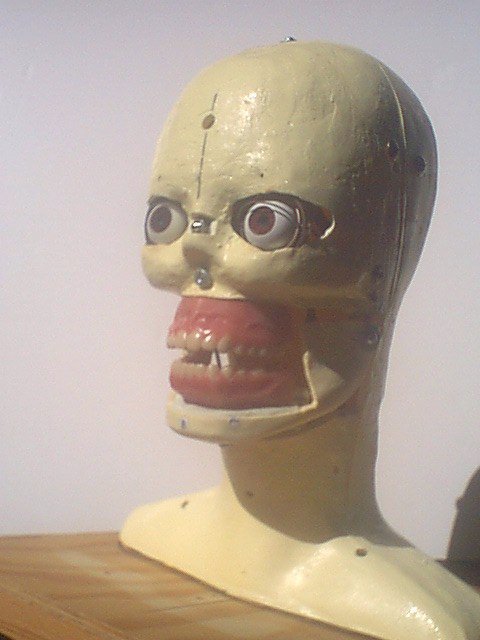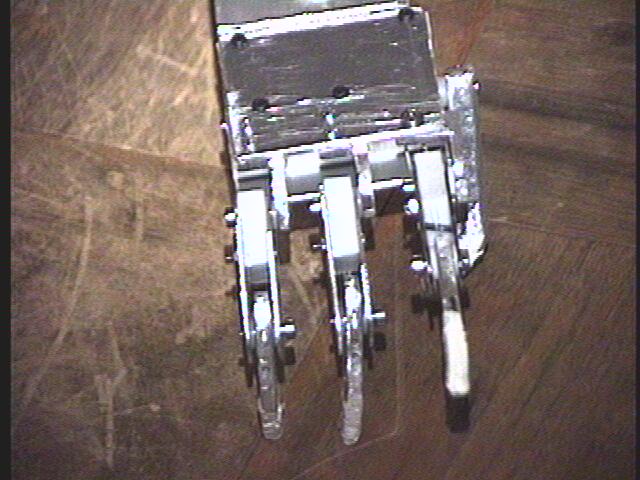 Domestic robots have already entered the market and they help in doing mundane household chores like vacuum cleaning, ironing of clothes and even home security. But despite their usefulness they are rarely humanoid in apperance. These include the disc-shaped vacuum cleaning robot Roomba by iRobot, or the Dressman by Siemens which is a mannequin-shaped robot with balloon silk skin that inflates itself with hot air and presses clothes, or the Aibo, the “dog” by Sony which functions as a family pet while guarding the house with a .3 megapixel camera to snap intruders. Some domestic humanoids that have been developed so far include Asimo by Honda and Wakamaru by Mitsubishi Heavy Industries.
Domestic robots have already entered the market and they help in doing mundane household chores like vacuum cleaning, ironing of clothes and even home security. But despite their usefulness they are rarely humanoid in apperance. These include the disc-shaped vacuum cleaning robot Roomba by iRobot, or the Dressman by Siemens which is a mannequin-shaped robot with balloon silk skin that inflates itself with hot air and presses clothes, or the Aibo, the “dog” by Sony which functions as a family pet while guarding the house with a .3 megapixel camera to snap intruders. Some domestic humanoids that have been developed so far include Asimo by Honda and Wakamaru by Mitsubishi Heavy Industries.

 However, Chris Willis of Androidworld.com is working on a prototype domestic android named Valerie. Androids are robots which have been designed to look and behave like humans. Thus, they are not only bi-pedal but also talk and look like humans. Valerie has been promised to be able to clean the house, change the light bulbs, and wash the clothes and also do dishes. She can even check the sports scores, book plane tickets and even notify the police during emergencies. Valerie has been designed to speak English and Willis promises that she will be able to understand English as well. That means that she can be programmed by non-programmers without knowledge of programming languages.
The expected cost of Valerie is US $59,000 plus a 2 year warranty.
However, Chris Willis of Androidworld.com is working on a prototype domestic android named Valerie. Androids are robots which have been designed to look and behave like humans. Thus, they are not only bi-pedal but also talk and look like humans. Valerie has been promised to be able to clean the house, change the light bulbs, and wash the clothes and also do dishes. She can even check the sports scores, book plane tickets and even notify the police during emergencies. Valerie has been designed to speak English and Willis promises that she will be able to understand English as well. That means that she can be programmed by non-programmers without knowledge of programming languages.
The expected cost of Valerie is US $59,000 plus a 2 year warranty.
 In terms of locomotion, Valerie may just be the most advanced to be shown in public. With 40 degrees of freedom in its entire body, it is comparable to Honda’s Asimo with only 30 degrees of freedom in it entire body. Of the entire body, Willis the movement of the hands themselves make up to 30% of the project because of the complex tasks that Willis expects Valerie to perform. Pictures and development of hands and other parts can be found in http://www.androidworld.com.
In terms of locomotion, Valerie may just be the most advanced to be shown in public. With 40 degrees of freedom in its entire body, it is comparable to Honda’s Asimo with only 30 degrees of freedom in it entire body. Of the entire body, Willis the movement of the hands themselves make up to 30% of the project because of the complex tasks that Willis expects Valerie to perform. Pictures and development of hands and other parts can be found in http://www.androidworld.com.
 Bi-pedal movement is another challenge that Willis is confident that Valerie can overcome through the use of a vision system, a gyro accelerometer board and the sense of touch in the feet. In comparison, Valerie has 30 force sensors in each feet compared to Asimo with 6. Willis thinks that the key to walking is by increasing mobility in the pelvic region.
Bi-pedal movement is another challenge that Willis is confident that Valerie can overcome through the use of a vision system, a gyro accelerometer board and the sense of touch in the feet. In comparison, Valerie has 30 force sensors in each feet compared to Asimo with 6. Willis thinks that the key to walking is by increasing mobility in the pelvic region.
Admittedly the project is extremely ambitious and there are many problems However, it is interesting to note that Willis has already sold 3 prototypes that were destined for delivery in late 2004. Willis is optimistic of being a major player in this futuristic technology that has been invested heavily by the likes of names like Honda, Fujitsu, Sony, Toyota, Takara, Omron, sega, bandai, NEC, Mitsubishi, Kawasaki, Tsmuck, Sanyo and Epson. The website http://www.androidworld.com/prod19.htm shows the progress of the Valerie Project and discusses the technology that is used in Valerie’s android capabilities. For speech, the AT&T speech synthesizer which is the website claims to be the most human-sounding voice available today is used. This can be tested by going to the website http://public.research.att.com/~ttsweb/tts/demo.php. In terms of hearing, Valerie has is biaural. Vision, is colour binocular and uses the PC207XP Color Microvideo CMOS Camera from Supercircuits at http://www.supercircuits.com/. More information on the android eyes can be found at http://www.androidworld.com/prod31.htm.
For artificial intelligence, the domestic android will be using the following learning methods Rote memory, visual imitation, Logical inference, Fuzzy logic, and Neural networks.

In terms of muscular movement the following muscle mechanisms are used: Pneumatics for medium muscles, hydraulics for strong muscles, steppers for small fast muscles and servos for small slow muscles.

All in all, these give Valerie the following capabilities which would make her one of the most advanced domestic robot to date:
- Muscle movements equal to a person. - Understand spoken commands (in several languages) - Speak to you in English (or several other languages) - Remember previous conversations. - Remember a daily list of chores to be done. - Perform household chores such as: - Cleaning - Clearing the table - Changing light bulbs - Doing laundry - Dusting - Lift and carry things up to 50 pounds - Picking up things - Putting things away - Painting - Setting the table - Sweeping - Washing dishes - Vaccuuming - Access the internet to do such things as: - Check stock prices - Check sports scores - Find information for you - Book plane tickets for you - Find addresses or phone numbers - Find directions - Call police in an emergency. - Call the fire department in case of fire. - Dress or undress herself. - Have a sense of touch all over like people do.
Willis is expecting the demand for personal robots to rise over the next 10 years and is keep track of all the 60 or so android projects around the world to stay ahead of the competition. He is expecting as much as 10% of US households to have home robots of some kind. That sure sounds like science fiction becoming reality. Reference http://www.cochrane.org.uk/opinion/articles/17-01-2006.php http://www.gizmag.co.uk/go/2545/ http://www.androidworld.com/prod19.htm
4 comments:
u0204569 Tan Wen Pin
I think that robots are made to look like humans due to physchological and cognitive reasons. When robots look like something that is "unfamiliar", they are viewed as hostile and "hard to apprehand". This is especially true to the older not-so-highly educated generations. In this case, the robot is made to look like a girl. Well, who doesn't like aesthetics ?
U0204840 Lin Ming Zheng
I agree. making a robot look more human will definitely make some people feel more comfortable in the pressence of robots. Recall the movie A.I. , the "robots" in the movie look so much like humans that u cannot differentiate between them. I wonder if this is possible in the future.
u0205081 Chow Synn Nee
hmm.. looking at all the humanoid and android robots, it really made me wonder why there is a need to make robots so human-like. wouldn't anyone be afraid of such machines loitering around their homes, which look like humans but are actually made of cold, hard metal? what i mean is, machines should, somehow, in a way, erm.. still look like a machine.. hmm.. well, this is just my personal opinion..
Name: Ooi Yi Xiang Patrick
Matriculation Number: U036703E
Email UserID: u0303375
Personally I feel that a humanoid design may not be the most optimal for domestic chores. The reasons why people design humanoid robots is because they may want to interact with something which looks familiar or appealing. Also, the human imagination may be limited by the fact that we see so many human beings every day and our designs are somehow limited to that. But more hands would definitely be better for tasks which require more strength or for tasks which are more complicated.
There are many other non-humanoid features which can be implemented too and it’s just whether the engineers can think of the best design for a robot to perform as many tasks as possible. Maybe the robot can even change forms depending on the task at hand (think Transformers). The possibilities are limitless and it may be hard to think too, but I believe certain people have good enough imaginations to think of designs to solve most problems.
Post a Comment